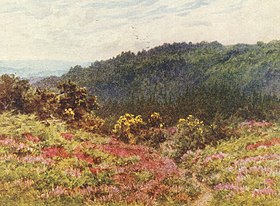Blackdown, West Sussex
| Blackdown | |
|---|---|

View of Blackdown, painted by Helen Allingham, 1902
|
|
| Highest point | |
| Elevation | 280 m (920 ft) |
| Prominence | 191 m (627 ft) |
| Parent peak | Leith Hill |
| Listing | Marilyn, County Top |
| Coordinates | 51°03′30″N 0°41′24″W / 51.0584°N 0.69006°WCoordinates: 51°03′30″N 0°41′24″W / 51.0584°N 0.69006°W |
| Geography | |
|
Blackdown in West Sussex
|
|
| Location | Western Weald, South Downs National Park, England |
| OS grid | SU919296 |
| Topo map | OS Landranger 197 |
Blackdown, or Black Down, is the highest hill in the historic county of Sussex, at 280 metres (919 feet). In southeastern England it is exceeded only by Walbury Hill and Leith Hill.
It is also the highest point in the South Downs National Park. The pine- and heather-covered slopes are owned by the National Trust and are a favourite walking spot. Blackdown has strong literary associations with the poet Alfred, Lord Tennyson.
The great black mass of Blackdown looms over much of the Low Weald of west Sussex and south-west Surrey. Geologically part of the Greensand Ridge and lying on the western margins of the Weald, Blackdown nevertheless lies within the South Downs National Park. It is situated about 1.2 miles (1.9 km) south of Haslemere, and its northern slopes in fact lie within the county of Surrey. There are no villages on Blackdown, but Fernhurst is just to the southwest, and Lurgashall to the southeast.
There are National Trust car parks on Tennyson's Lane, which runs up Haste Hill from Haslemere, and a footpath from the town centre. It is also possible to walk to Blackdown from Lurgashall, although this means walking up the steep southern escarpment. Blackdown is crossed by the Sussex Border Path and the Serpent Trail.
The secluded sunken lane that runs from Haslemere past Aldworth is named Tennyson's Lane in memory of the poet. It is little changed from Arthur Paterson's description in 1905:
Trees meet overhead, copsewood surrounds it, and later, it is hedged by high sandy banks thickly overgrown with plant and scrub; squirrels and rabbits, and all other small woodland creatures, disport themselves over it. It twists and turns, and to the stranger appears to lead nowhere in particular.
...
Wikipedia

